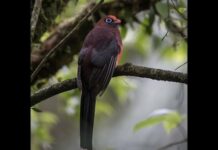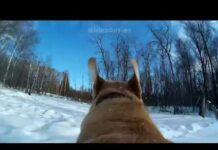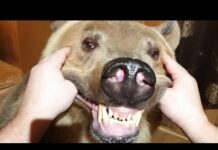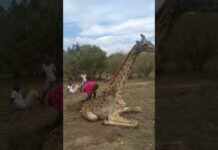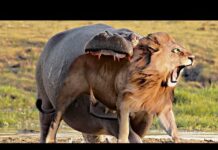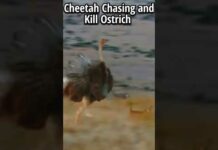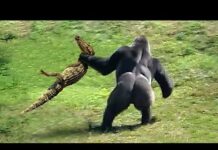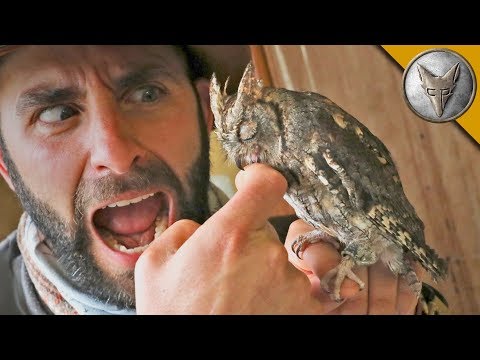First Adventure Kit still available – LIMITED TIME! – http://bit.ly/ADVENTUREKIT
Join our channel as a member for exclusive perks! – http://bit.ly/JOINBWM
Coyote’s Newest book – http://bit.ly/KINGOFSTING
Please SUBSCRIBE – http://bit.ly/BWchannel
Join the official Coyote Pack! – http://bit.ly/JOINTHEPACK
Brave Wilderness on Instagram: http://bit.ly/IGbrave
On this episode of Breaking Trail, we count down the top 5 birds ever featured on the Brave Wilderness channel! And… Coyote gets bitten by an owl along the way?!
Get ready, you’re about to see if a sleepy owl BITES Coyote!
Breaking Trail leaves the map behind and follows adventurer and animal expert Coyote Peterson and his crew as they encounter a variety of wildlife in the most amazing environments on the planet!
The Brave Wilderness Channel is your one stop connection to a wild world of adventure and amazing up close animal encounters!
Follow along with adventurer and animal expert Coyote Peterson and his crew as they lead you on seven exciting series – Emmy Award Winning Breaking Trail, Beyond the Tide, Dragon Tails, On Location, Base Camp, Blue Wilderness and Beyond Dinosaurs – featuring everything from Grizzly Bears and Crocodiles to Rattlesnakes and Tarantulas…each episode offers an opportunity to learn something new.
So SUBSCRIBE NOW and join the adventure that brings you closer to the most beloved, bizarre and misunderstood creatures known to man!
GET READY…things are about to get WILD!
New Episodes Every Friday and Sunday
– Dude what's up? – Aw, she pooped all over my jacket. – That means she likes you. – Tiny. (toucan chirping) There you go. Oh, he's eating the spoon. I would say that the only thing this bird is missing is a tail and if it had one,.
It really would be a dinosaur. (suspenseful music) (animal roars) (exciting music) Animals are perfectly adapted to thrive in their environments. Aquatic creatures are usually designed with streamlined bodies and have enhanced electromagnetic receptors.
That help them navigate effectively through their watery ecosystems. Land-dwelling creatures on the other hand often rely on their appendages for navigation. Some have four legs, some have 100 legs, and others don't have any legs at all. Today we're going to focus on a class of animals that transcend almost all other species when it comes to both navigation and locomotion:.
Birds. It's no secret that birds have been notoriously difficult to feature on the channel because unlike most animals we get up close with the cameras, they are nearly impossible to catch. And while we do occasionally see them from a distance, most of the avian species we have encountered were birds living or being rehabilitated at wildlife sanctuaries.
The Coyote Pack has been asking for more bird episodes so we thought, maybe it was time to count down our top five feathered friends. Coming in at number five, these birds might not be the biggest. What they lack in size, they definitely make up for with speed. (orchestral music) So excited, I absolutely love hummingbirds.
All right let's head into the aviary, gotta move quick, we gotta go through a set of double doors, in you go. Go go go, get that door closed and into the aviary we go. Shawnee, hi, how are you? Nice to meet you. – Nice to meet you too. – Okay so let's talk about wing speed. There's one incredible trait that the hummingbird has, it's the fact that its wings can go so fast. Now how many strokes can that hummingbird.
Do this a minute? – Almost 4800. – Wow, 4800 strokes in a minute, can you imagine that? I'm sure if I sat here and did this– – I don't think you'd get it. – It would take me half a day and I'm not gonna lift off the ground and these hummingbirds, I'm watching them. Look at this, they're just flying back and forth, hovering and they can move forward, backwards, up and down.
That's crazy. – That's great, yeah. – Now your heart rate must be going pretty quick if you're flying that fast, how fast are their heart rates? – Over 1200 beats per minute. – This is one impressive little animal, that is for sure. All of that power packed into, these guys are tiny, they're like that. – Yeah. About three grams so that's about the weight of a penny. – Wow so you're telling me that a bird this size,.
I mean he is tiny, but he only weighs as much as a penny. – Yeah. – That is impressive. Shawnee, what I love so much about this aviary is that it feels like we're out there in the wild. Now you do have the enclosure over top but you barely notice it, and you can get so incredibly close to these hummingbirds. – I know, it's a terrific experience. – Oh geez!.
Look at how close this one is right here! – Absolutely! – Look at that! Look at how comfortable he is getting that close to us. Wow. The Arizona Sonora Desert Museum is one of my favorite places to visit and their hummingbird aviary is guaranteed to get you up-close with these speedy little birds.
Up next is another teeny tiny species, only instead of feasting on nectar, this one is a veracious predator. Coming in at number four on our feathered favorites countdown, get ready to meet the scops owl. (orchestral music) Are you ready to meet the smallest owl ever? Get ready to meet Tiny, the African scops owl.
So cute, this one's like pocket size. I wish I could fit her right into my jacket but she likes hiding behind it but I don't think she'd actually wanna go in a pocket. Look at the claws. Those talons are razor sharp. I was just trying to look at your talons. Razor sharp talons, you notice I'm trying to talk very quietly next to the owl.
Don't wanna scare it, don't wanna stress it out. They have incredible hearing so any shouting next to the owl is gonna not be good for it. All owls are lightweight, they're mostly feathers and as we know, they have hollow bones but this owl right here weighs about 100 grams. That's it, that's one tiny little bird of prey. Look at how big those eyes are. Yes, very cute.
You see just blinking at me and as we know, all species are nocturnal and they have incredibly efficient vision in the dark. So Tiny is a female, now when they lay a clutch of eggs, it's somewhere between two and four eggs and the mother and the father both take care of the babies, oftentimes the mother will stay in the nest when the father goes out and hunts, bringing that food back to the nest for the mother.
And once the chicks hatch, they then also reap the benefits of that prey. I got an idea, you know what I've got right over here? – Cookies? – Meal worms. No not cookies, these are considered cookies for an owl though. We've got these little tiny meal worms and let's see, this is me feeding a teeny tiny owl. Oh there you go, that's good.
Delicious, right? – Dude, what's up? – Aw, she pooped all over my jacket. – That means she likes you. – Tiny. Oh it smells like rotten eggs. South Africa's adventures were sure filled with poop. From dung beetles to poop tracking and then of course, the incident with Tiny.
But even with her bites and poos, this scops owl was a ton of fun to work with. Flying into our number three slot is a bird that was much more squawky but no less messy. If you enjoyed watching trying to feed tiny, you're going to love our next star, the baby toucan. (orchestral music) This is the real Froot Loops right here. This is fresh-cut fruit and what I'm about.
To do is feed it to a baby toucan. It smells really good, this looks like something that I would eat for breakfast so I have a feeling that this toucan is absolutely gonna love it. Okay, oh boy here he comes. Whoa, look at that. That is a baby toucan. I have never seen one of these before. That is so amazing.
You look like a little dinosaur. Look at that curious head. Look what I've got. Now if I was a mama toucan, I would come in with some fruit just like this. There you go. Oh, he's eating the spoon. Look at that beak, quite the chomper. Here you go, coming in, coming in hot.
There we go. And although it's a juvenile, that beak could still give me a pretty good chomp so I wanna keep my fingers away from there, that's why I'm using a spoon. Here you go. Look at those eye, look at how big and buggy his eyes are. And without the feathers fully developed on the neck, you can see the curve of that vertebrae.
Look at the feet. You see that? You know what it looks like, it reminds me of a baby pterodactyl. A baby toucan this size obviously up in the trees, it's very important that he uses these claws to keep himself in the nest and on the tree branches. Now this baby toucan eats four times a day, and quite a bit of food. (toucan squawking).
Oh I know, I hear you. Want more, more, he says. You are one sloppy eater, you know that? – He is a sloppy eater. – I think you're getting more of this fruit on the log than you are in your mouth. We featured a plethora of cute animals at the Alturas Wildlife Sanctuary but nothing was more adorable than that noisy little toucan.
The next bird encounter is actually the only one on the list that took place in the wild. And boy was it a challenge to track down these majestic creatures. Soaring in at number two, it's the bald eagle. (orchestral music) So just up here to my left, we've got two eagles right on the shoreline. Filming eagles is not easy, they can be very skittish.
We wanna move in as slow as you possibly can, stay stealthy, set up the 600 millimeter lens and try to get this shot. (soft music) We've been on the river for hours looking for this one opportunity to actually film these eagles. I think this is it, I'm so excited. So right now we're trying to sneak in close on the eagles. Mark's got the 600 millimeter, we're trying to stay.
At a straight line so that the animals only think it's one human sneaking up on 'em. Careful this is sink mud. – Running speed. – Wow, that's cool. Now, the two eagles that we're looking at, that is pretty much the king and queen of what's considered the eagle council grounds. And in the winter, there will be over 1,000 eagles.
Right here where these two rivers converge. The water doesn't actually freeze, so it's like an eagle buffet line of eating all these salmon that are still swimming upstream. Okay so right now, we're gonna slowly try to move in and get an even better shot. (soft music) – Okay, so we're changing up the strategy.
Just a touch here. – Yup. – Mark's gonna be up front, operating the 600 millimeter from the front of the raft. We've got an eagle up here in the trees. We're gonna try to do a drift-by and get an epic shot. You ready for this? All right, load it up. – All right, get in. – We've got a mature eagle up in the tree, so we're gonna try to just drift by and get a shot.
And maybe it'll fly just as we're passing underneath it. It's the closest we've been to a bird all day long. Mark's perched up on this log and he's getting the shot. (soft music) – Got it. – Yeah. – One day we hope to return to Alaska, with the goal of getting an even closer look at these iconic birds and maybe even hands-on.
With one at an eagle sanctuary. Well, we started small and seemed to be working up in size. Next on our list is the largest bird we have ever had the chance to work with. It also happens to be the world's most dangerous bird and a true avian dinosaur. (orchestral music) Look at how ancient-looking that face is and the coloration in the skin, the crest of the head.
Wow, the crest is a lot bigger than I imagined it to be and that's hollow, right? – [Bearded Man] It is hollow. – But it's still, it's real fibrous, right? – Very fibrous. – Ram me in the face with it so I definitely have to be careful. – It's very similar in density to a beak. – Okay, so she's running through the environment, she can kinda just keep her head down.
And break through all the underbrush. – Definitely and what they do is they stretch their neck out real long which will extend a few feet in front of their body as they're running. That'll help push the branches away from her, the rest of her body as she runs. And I'm not sure if you notice this but if you look around the side here, you're gonna see these wings. – Yes.
Little tiny wings. – Yeah. And they have really stiff quills. – Wow, look at that. – Yeah. – Almost looks like a porcupine's quill. Look at the size of this bird's legs. Look at all the scales. This bird weighs about 130 pounds. That is a massive animal, this is the second largest species of bird in the world, second only to the ostrich.
And they're incredibly fast. – They are extremely fast. They can run around 30 miles per hour through jungle underbrush. – Wow. I would say that the only thing this bird is missing is a tail and if it had one, it really would be a dinosaur. Hi, here you go. Look at this skin. You wouldn't expect a bird.
To have bright blue skin like that. It's so beautiful and here's something you might not know, that the entire bird's body is blue. If I just fold back those feathers a tiny bit, look at that. Blue all the way through. Their feathers are incredibly coarse. These ones on the outside here almost feel like horse hairs and then underneath, she's really soft and downy.
When you look at the feet of this bird, look at those scales and look at the claws. It looks just like the foot of a velociraptor, and that claw on the inside edge of the foot, razor sharp. Now if this bird was out in the wild and actually a couple inches longer and sickle shaped, just like a raptor. And these birds are capable of jumping almost six feet in the air.
And I can't even imagine how terrifying it would be to be out there in the jungle, have one of these cut through the underbrush, run at you, leap, and you take one of those claws to the face. And when you look down the length of that beak and into those eyes, you transcend back 65 million years into the past, and you feel as if you were looking straight at a dinosaur. Wow, that is intimidating right here.
Everyone knows how much I love dinosaurs, and my interaction with a cassowary was about as close as I'll ever come to staring down the snout of a pre-historic creature. Birds are one of the most unique species on our planet, and we do plan to feature more of them in the near future. Do you have a favorite species that you would like us to feature? If so, put your top five bird encounters.
In the comment section below and we will see how many of them we can capture on camera. If you thought getting up close with a cassowary seemed intimidating, make sure you go back and watch the episode where I challenged this avian dinosaur to an apple eating contest, and don't forget, subscribe and click the notification bell so you can join me and the crew on our next wild adventure.
(animals bellowing)
We are excited to present to you the captivating video titled “SLEEPY OWL BITES ME?!”. Get ready to embark on a journey of enjoyment, smiles, and laughter as you watch this delightful creation. “SLEEPY OWL BITES ME?!” is a perfect blend of entertainment and amusement, carefully crafted to bring joy to your day. From the moment you press play, you’ll be greeted with a cascade of lighthearted moments, heartwarming scenes, and perhaps even a few surprises that will tickle your funny bone.
Whether you’re in need of a quick pick-me-up or simply looking for some light-hearted entertainment, “SLEEPY OWL BITES ME?!” has you covered. The video promises to deliver a collection of moments that are bound to leave you grinning from ear to ear. With its engaging content and skillful presentation, “SLEEPY OWL BITES ME?!” is more than just a video – it’s an experience designed to brighten your mood and spread positivity.
The creators of “SLEEPY OWL BITES ME?!” have poured their creativity and dedication into crafting a visual treat that resonates with audiences of all ages. Through expert storytelling, impeccable timing, and an array of engaging content, “SLEEPY OWL BITES ME?!” promises to be an unforgettable journey that lingers in your memory long after the video concludes.
So sit back, relax, and prepare to be entertained as you dive into the world of “SLEEPY OWL BITES ME?!”. It’s a delightful video that aims to bring a dose of happiness to your day, leaving you with a lasting smile and a heart full of laughter.
This video was uploaded in youtube and has recieved 3118767 views so far. This is a great achievement and laso it has received 46093 likes and .
Data bout the video:
Rating: ,
Video dimensions: 2d,
Video definition: hd,
Video duration: 00:14:33,
Video favourite count: 0
Video comment count: 3030


